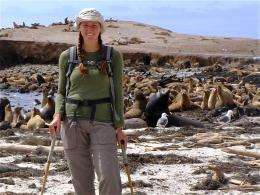Scientists use 'crowd funding' to secure research funds

When Tara Crawford saw a fishing net wrapped around a young California sea lion’s neck, cutting into its flesh and causing an infection, it reinforced her motivation to help these animals through her research.
Crawford spent several weeks last summer assisting scientists who are studying a colony of these animals. However, as a third-year ASU doctoral student learning about wildlife ecology in the School of Life Sciences, she faces a dual task: not only to help understand the problem of sea lion entanglement and how best to manage it, but also to overcome the hurdle of securing enough funding to conduct research that has the necessary impact.
As a scientist just beginning her career, Crawford must compete against other students and researchers for the limited dollars available from traditional funding sources such as foundations, private institutions, nonprofit organizations and the government. In fiscal year 2010-2011, just 24 percent of the proposals submitted by principal investigators with ASU’s School of Life Sciences were financed.
Funding rates reported by the National Institutes of Health for that same time period were at historic lows, 17.4 percent; with funding rates for new investigators, like Crawford, closer to 17 percent through the National Science Foundation. With odds like these, Crawford decided it was time to try something new.
She is participating in an international effort called the #SciFund Challenge – organized in 2011 by ecologists Jai Ranganathan, with the National Center for Ecological Analysis and Synthesis (NCEAS) in California, and Jarrett Byrnes, a postdoctoral fellow with NCEAS, as an experiment to see whether “crowd funding” can be an effective tool to help fund science research. Most often organized via the Internet, crowd funding is basically a collective effort to raise funds and resources for an individual, organization or project.
During the month of May, more than 140 scientists from around the world are participating in the 2012 #SciFund Challenge in an effort to connect with the public.
“So, I’m trying to gain funding for one aspect of my dissertation research,” said Crawford. “This part is focused on reducing entanglement of sea lions in fishing gear, specifically at a breeding colony in the Gulf of California that frequently encounters this problem. We don’t know where the fisheries and sea lions are interacting because we don’t know where sea lions go when they are at sea. The first step is discovering where they are likely to become entangled.”
Once she submitted her proposal to #SciFund Challenge, Crawford created a video designed to build rapport with potential funders. Also, she set a campaign goal, developed incentives, and detailed the broad relevance of her research plans. Her challenge went “live” on May 1.
She has only two weeks remaining to reach her financial goal of $5,000.
“The broader, theoretical focus of my research is to understand the role of the individual animal in the context of population dynamics,” added Crawford. “Wildlife management typically assumes that all individual members of a population are the same. In reality,” she explained, “animals have different preferences and abilities that may expose them to different risks. From a management perspective, if we understand the underlying drivers of population dynamics, we can prioritize our actions and make better management decisions.”
Crawford is not the only graduate student delving into crowd funding for support. Rusty Ligon, a third-year life sciences doctoral student in the School of Life Sciences, in the College of Liberal Arts and Sciences, believes this could become a more common method for graduate students to pursue funding for their research. He recently completed a 60-day campaign – seeking crowd funding for his research studying the control and signaling function of chameleon color change, particularly during social interactions and competitions between males.
“For a graduate student who is working on a project with little external support, this is really a good way to get a lot of feedback and get your general research concept out there,” said Ligon. “In terms of the amount of time invested to dollar return, this is better than a lot of the small grants available to people who study things like I do – animals and physiology and behavior. It’s common to spend 20 plus hours writing a grant for $500. To have spent maybe 40 hours on my website, and raise over $1,700 is a fantastic return.”
In the first round of the #SciFund Challenge in 2011, participants raised more than $76,000 in about six weeks. In just the first nine days of the second round, nearly $50,000 has already been donated to the various projects.
“This is a great example of how all researchers can be effective science communicators in today’s multi-media environment,” said Brian Smith, director of ASU’s School of Life Sciences. “Crowd funding allows researchers to connect science to a wider public,” he added. “As we search for better ways to address the pressing scientific issues facing our world today, connecting science to society will be more and more important.”
For both students, the understanding that people are making a personal investment in their research is both humbling and inspiring.
“People are investing in me,” said Crawford. “There is a huge sense of responsibility to use this funding wisely and I am accountable to them personally.”
Ligon added, “I don’t know if this is the wave of the future, but I think it’s part of the future since the budgets for many traditional grant giving agencies are getting smaller.”
Reaching a wider audience and maintaining a high degree of exposure for their research projects have proved to be challenging for both Crawford and Ligon. Despite that, these students plan on maintaining their efforts to reach out and hope that crowd funding will offer them a way to make a difference.
Provided by Arizona State University
















